A Spatio-Temporal Analysis of Heat Island Intensity Influenced by the Substantial Urban Growth between 1990 and 2020: A Case Study of Al-Ahsa Oasis, Eastern Saudi Arabia
Abstract
:1. Introduction
2. Materials and Methods
2.1. Study Area
2.2. Data Types and Preprocessing
2.3. Classification of LULC and Assessing Its Accuracy
2.4. LULC Change Detection
2.5. Estimation of LST
2.6. LST Calculation
2.7. NDBI
2.8. Mapping UHIs and UHI Intensity and Impact Assessment
2.9. Spatial Autocorrelation Analysis
2.9.1. Hot Spots Analysis
2.9.2. Grid Map Delineation and Class Pixels Extraction
2.9.3. Application of Spatial Autocorrelation
3. Results
3.1. Classification of LULC and Assessing Its Accuracy
3.2. Land Cover Statistics and Change Rate
3.3. Estimation of LST
3.4. Analysis of NDBI
3.5. Analyzing the Spatial Pattern of NDBI and LST’s Hot and Cold Spots
3.6. Depicting the Spatial Autocorrelation between Variation Patterns
4. Discussion
5. Conclusions
- The technique of change detection was performed (with classification accuracies between 90 and 96%) to measure and map possible growth in urbanization and its effect on UHIs and UHI intensity quantification. The obtained change values revealed a considerable rate of growth in the urban area of 17.15% to 45.8% of the total LULC from 1990 to 2020, respectively.
- Considering the intensity of heat islands (which represents the difference between heat islands for urban areas and heat islands for suburbs), no abrupt variations were observed. The intensities ranged between 10.4 °C for 1990 and 8.7 °C for 2020.
- Taking into account the spatial distribution of UHIs, a remarkable consistency was observed throughout all study periods between NDBI and the LST, specifically over the western, eastern, and northern parts of the study site, where intense built-up complexes of main cities and villages are situated.
- A spatial autocorrelation analysis consisting of hot spots analysis and the BiLISA approach was implemented to identify particular relationships and clustering of variables. Further, it was intended to reveal the extent to which the nature of the association between the urban sprawl and UHIs can change. We found that most of the areas in the western, eastern, and southeastern parts (designated as built-up surfaces) had experienced hot spots, while areas covered with palm trees experienced clustering zones of cold spots, with 99% confidence for both. On the other hand, the BiLISA spatial autocorrelation revealed a significant consistency between LST and NDBI, with Moran’s I values of 0.41 and 0.45 for 1990 and 2020, respectively, with a significance (p-value) of 0.001 for all periods.
Author Contributions
Funding
Institutional Review Board Statement
Informed Consent Statement
Data Availability Statement
Acknowledgments
Conflicts of Interest
References
- Rasul, A.O. Remote sensing of surface urban cool and heat island dynamics in Erbil, Iraq, between 1992 and 2013. Ph.D. Thesis, University of Leicester, Leicester, UK, 2016. [Google Scholar]
- Oke, T.R. Boundary Layer Climates, 2nd ed.; Routledge: London, UK, 1987. [Google Scholar]
- Lee, S.; French, S.P. Regional impervious surface estimation: An urban heat island application. J. Environ. Plan. Manag. 2009, 52, 477–496. [Google Scholar] [CrossRef]
- Lee, J.S.; Kim, J.T.; Lee, M.G. Mitigation of urban heat island effect and greenroofs. Indoor Built Environ. 2014, 23, 62–69. [Google Scholar] [CrossRef]
- Chow, W.T.; Brennan, D.; Brazel, A.J. Urban heat island research in Phoenix, Arizona: Theoretical contributions and policy applications. Bull. Am. Meteorol. Soc. 2012, 93, 517–530. [Google Scholar] [CrossRef] [Green Version]
- Tarle, M. Application of GIS in Defining Urban Heat Island Using Transect Data: Urban Heat Island Using GIS Mapping; Lambert Academic Publishing: Saarbrücken, Germany, 2010. [Google Scholar]
- U.S. Environmental Protection Agency. Urban Heat Island Basics. In Reducing Urban Heat Islands: Compendium of Strategies; U.S. Environmental Protection Agency: Washington, DC, USA, 2008. [Google Scholar]
- Almulhim, A.I.; Bibri, S.E.; Sharifi, A.; Ahmad, S.; Almatar, K.M. Emerging Trends and Knowledge Structures of Urbanization and Environmental Sustainability: A Regional Perspective. Sustainability 2022, 14, 13195. [Google Scholar] [CrossRef]
- Li, H.; Zhou, Y.; Li, X.; Meng, L.; Wang, X.; Wu, S.; Sodoudi, S. A new method to quantify surface urban heat island intensity. Sci. Total Environ. 2018, 624, 262–272. [Google Scholar] [CrossRef]
- Kuang, W.; Liu, Y.; Dou, Y.; Chi, W.; Chen, G.; Gao, C.; Yang, T.; Liu, J.; Zhang, R. What are hot and what are not in an urban landscape: Quantifying and explaining the land surface temperature pattern in Beijing, China. Landsc. Ecol. 2015, 30, 357–373. [Google Scholar] [CrossRef]
- Azevedo, J.A.; Chapman, L.; Muller, C.L. Quantifying the daytime and night-time urban heat island in Birmingham, UK: A comparison of satellite derived land surface temperature and high resolution air temperature observations. Remote Sens. 2016, 8, 153. [Google Scholar] [CrossRef] [Green Version]
- Buyantuyev, A.; Wu, J.G. Urban heat islands and landscape heterogeneity: Linking spatiotemporal variations in surface temperatures to land-cover and socioeconomic patterns. Landsc. Ecol. 2010, 25, 17–33. [Google Scholar] [CrossRef]
- Kamali Maskooni, E.; Hashemi, H.; Berndtsson, R.; Daneshkar Arasteh, P.; Kazemi, M. Impact of spatiotemporal land-use and land-cover changes on surface urban heat islands in a semiarid region using Landsat data. Int. J. Digit. Earth. 2021, 14, 250–270. [Google Scholar] [CrossRef]
- Kumar, D.; Shekhar, S. Statistical Analysis of Land Surface Temperature–Vegetation Indexes Relationship Through Thermal Remote Sensing. Ecotoxicol. Environ. Saf. 2015, 121, 39–44. [Google Scholar] [CrossRef]
- Yuan, F.; Bauer, M.E. Comparison of Impervious Surface Area and Normalized Difference Vegetation Index as Indicators of Surface Urban Heat Island Effects in Landsat Imagery. Remote Sens. Environ. 2007, 106, 375–386. [Google Scholar] [CrossRef]
- Sultana, S.; Satyanarayana, A.N.V. Assessment of Urbanisation and Urban Heat Island Intensities Using Landsat Imageries During 2000–2018 Over a Sub-Tropical Indian City. Sustain. Cities Soc. 2020, 52, 101846. [Google Scholar] [CrossRef]
- Grigoraș, G.; Urițescu, B. Land use/land cover changes dynamics and their effects on surface urban heat island in Bucharest, Romania. Int. J. Appl. Earth Obs. Geoinf. 2019, 80, 115–126. [Google Scholar] [CrossRef]
- Atasoy, M. Assessing the impacts of land-use/land-cover change on the development of urban heat island effects. Environ. Dev. Sustain. 2020, 22, 7547–7557. [Google Scholar] [CrossRef]
- Tran, H.; Uchihama, D.; Ochi, S.; Yasuoka, Y. Assessment with satellite data of the urban heat island effects in Asian mega cities. Int. J. Appl. Earth Obs. Geoinf. 2006, 8, 34–48. [Google Scholar] [CrossRef]
- Hafner, J.; Kidder, S.Q. Urban Heat Island Modeling in Conjunction with Satellite-Derived Surface/Soil Parameters. J. Appl. Meteorol. 1999, 38, 448–465. [Google Scholar] [CrossRef]
- Zhou, X.; Chen, H. Impact of urbanization-related land use land cover changes and urban morphology changes on the urban heat island phenomenon. Sci. Total Environ. 2018, 635, 1467–1476. [Google Scholar] [CrossRef]
- Mochida, A.; Murakami, S.; Ojima, T.; Kim, S.; Ooka, R.; Sugiyama, H. CFD analysis of mesoscale climate in the Greater Tokyo area. J. Wind Eng. Ind. Aerodyn. 1997, 67, 459–477. [Google Scholar] [CrossRef]
- Magee, N.; Curtis, J.; Wendler, G. The urban heat island effect at Fairbanks, Alaska. Theor. Appl. Clim. 1999, 64, 39–47. [Google Scholar] [CrossRef]
- Li, D.; Liao, W.; Rigden, A.J.; Liu, X.; Wang, D.; Malyshev, S.; Shevliakova, E. Urban heat island: Aerodynamics or imperviousness? Sci. Adv. 2019, 5, 4299. [Google Scholar] [CrossRef] [PubMed] [Green Version]
- Kumar, A.; Agarwal, V.; Pal, L.; Chandniha, S.K.; Mishra, V. Effect of Land Surface Temperature on Urban Heat Island in Varanasi City. India. J. 2021, 4, 420–429. [Google Scholar] [CrossRef]
- Xian, G.; Shi, H.; Zhou, Q.; Auch, R.; Gallo, K.; Wu, Z.; Kolian, M. Monitoring and characterizing multi-decadal variations of urban thermal condition using time-series thermal remote sensing and dynamic land cover data. Remote Sens Environ. 2022, 269, 112803. [Google Scholar] [CrossRef]
- Halder, B.; Bandyopadhyay, J.; Khedher, K.M.; Fai, C.M.; Tangang, F.; Yaseen, Z.M. Delineation of urban expansion influences urban heat islands and natural environment using remote sensing and GIS-based in industrial area. Environ. Sci. Pollut. Res. 2022, 29, 73147–73170. [Google Scholar] [CrossRef] [PubMed]
- Al-Ali, A.M.H. The Effect of Land Cover on the Air and Surface Urban Heat Island of a Desert Oasis. Ph.D. Thesis, Durham University, Durham, UK, 2015. [Google Scholar]
- Abdullah, H. The Use of Landsat 5 TM Imagery to Detect Urban Expansion and Its Impact on Land Surface Temperatures in the City of Erbil, Iraqi Kurdistan. Master’s Thesis, University of Leicester, Leicester, UK, 2012. [Google Scholar]
- Al-Tahir, A.A.S. Al-Hassa: Geographic Study, 1st ed.; A-Hussainy Modern Press: Al-Hassa, Eastern Province, Saudi Arabia, 1999. [Google Scholar]
- Abdelatti, H.; Elhadary, Y.; Babiker, A.A. Nature and Trend of Urban Growth in Saudi Arabia: The Case of Al-Ahsa Province–Eastern Region. Resour. Environ. 2017, 7, 69–80. [Google Scholar]
- Elhadary, Y.A.; Al-Omair, A.A. Indicators and Causes of Rural Settlement Changes in Saudi Arabia: Alhasa Province in the Eastern District as Case Study. J. Gulf Arab. Penins. Studies. Gulf Arab. Penins. Stud. 2014, 155, 40. [Google Scholar]
- Salih, A. Classification and mapping of land cover types and attributes in Al-Ahsaa Oasis, Eastern Region, Saudi Arabia Using Landsat-7 Data. J. Remote Sens. GIS. 2018, 7, 228. [Google Scholar] [CrossRef]
- Alghannam, A.R.; Al-Qahtnai, M.R. Impact of Vegetation Cover on Urban and Rural Areas of Arid Climates. AJAE 2012, 3, 1–5. [Google Scholar]
- Al-Zara, I.A. Elemental Composition of Groundwater and Spring Waters in Al-Ahsa Oasis, Eastern Region Saudi Arabia. Trends Appl. Sci. Res. 2011, 6, 1–18. [Google Scholar] [CrossRef] [Green Version]
- Elsayed, I.S. A Study on Vulnerability of Alahsa Governorate to Generate Urban Heat Islands. Environ. Sci. Technol. 2016, 2, 392. [Google Scholar]
- Congedo, L. Semi-automatic classification plugin documentation. Release 2016, 3, 29. [Google Scholar]
- John, A.R. Remote Sensing Digital Image Analysis: An Introduction, 2nd ed.; Springer: New York, NY, USA, 1993. [Google Scholar]
- Anderson, J. Land-use classification schemes used in selected recent geographic applications of remote sensing. Photogramm. Eng. Rem. Sens. 1971, 37, 379–387. [Google Scholar]
- Pontius, R.G., Jr.; Millones, M. Death to Kappa: Birth of quantity disagreement and allocation disagreement for accuracy assessment. Int. J. Remote Sens. 2011, 32, 4407–4429. [Google Scholar] [CrossRef]
- Stehman, S.V.; Foody, G.M. Key issues in rigorous accuracy assessment of land cover products. Remote Sens. Environ. 2019, 231, 111199. [Google Scholar] [CrossRef]
- Olofsson, P.; Foody, G.M.; Herold, M.; Stehman, S.V.; Woodcock, C.E.; Wulder, M.A. Good practices for estimating area and assessing accuracy of land change. Remote Sens. Environ. 2014, 148, 42–57. [Google Scholar] [CrossRef]
- Ashbindu, S. Review Article Digital change detection techniques using remotely-sensed data. Int. J. Remote Sens. 1989, 10, 989–1003. [Google Scholar]
- Macleod, R.D.; Congalton, R.G. A quantitative Comparison of Change Detection Algorthms for Monitoring Eelgrass from Remotely Sensed Data. Photogramm. Eng. Remote Sens. 1998, 64, 207–216. [Google Scholar]
- Fu, P.; Weng, Q. A time series analysis of urbanization induced land use and land cover change and its impact on land surface temperature with Landsat imagery. Remote Sens. Environ. 2016, 175, 205–214. [Google Scholar] [CrossRef]
- Guo, G.; Zhou, X.; Wu, Z.; Xiao, R.; Chen, Y. Characterizing the impact of urban morphology heterogeneity on land surface temperature in Guangzhou, China. Environ. Model Softw. 2016, 84, 427–439. [Google Scholar] [CrossRef]
- Landsat Project Science Office, Landsat 8 Science Data User’s Handbook. Available online: https://landsat.usgs.gov/documents/Landsat8DataUsersHandbook.pdf (accessed on 13 February 2022).
- Sekertekin, A.İ.; Kutoglu, S.H.; Kaya, S. Evaluation of spatio-temporal variability in land surface temperature: A case study of Zonguldak, Turkey. Environ. Monit. Assess. 2016, 188, 30. [Google Scholar] [CrossRef]
- Johansen, B.; Tømmervik, H. The relationship between phytomass, NDVI and vegetation communities on Svalbard. Int. J. Appl. Earth Obs. Geoinf. 2014, 27, 20–30. [Google Scholar] [CrossRef]
- Silleos, N.G.; Alexandridis, T.K.; Gitas, I.Z.; Perakis, K. Vegetation indices: Advances made in biomass estimation and vegetation monitoring in the last 30 years. Geocarto. Int. 2006, 21, 21–28. [Google Scholar] [CrossRef]
- Simwanda, M.; Manjula, R.; Ronald, C.E.; Yuji, M. Spatial Analysis of Surface Urban Heat Islands in Four Rapidly Growing African Cities. Remote Sens. 2019, 11, 1645. [Google Scholar] [CrossRef] [Green Version]
- Pal, S.; Ziaul, S.K. Detection of Land Use and Land Cover Change and Land Surface Temperature in English Bazar Urban Centre. Egypt. J. Remote Sens. Space Sci. 2017, 20, 125–145. [Google Scholar] [CrossRef] [Green Version]
- Traore, M.; Lee, M.S.; Rasul, A.; Balew, A. Assessment of land use/land cover changes and their impacts on land surface temperature in Bangui (the capital of Central African Republic). Environ. Chall. 2021, 4, 100–114. [Google Scholar] [CrossRef]
- Zha, Y.; Gao, J.; Ni, S. Use of normalized difference built-up index in automatically mapping urban areas from TM imagery. Int. J. Remote Sens. 2003, 24, 583–594. [Google Scholar] [CrossRef]
- Alonso, M.S.; Fidalgo, M.R.; Labajo, J.L. The urban heat island in Salamanca (Spain) and its relationship to meteorological parameters. Clim. Res. 2007, 34, 39–46. [Google Scholar] [CrossRef]
- Shahmohamadi, P.; Ani, A.I.C.; Ramly, A.; Maulud, K.N.A.; Nor, M.F.I.M. Reducing urban heat island effects: A systematic review to achieve energy consumption balance. Int. J. Phys. Sci. 2010, 5, 626–636. [Google Scholar]
- Effat, H.A.; Taha, L.G.E.; Mansour, K.F. Change detection of land cover and urban heat islands using multi-temporal landsat images, application in Tanta City, Egypt. Open J. Remote Sens. Position. 2014, 1, 1–15. [Google Scholar] [CrossRef]
- Du, M.; Wang, Q.; Cai, G. Temporal and spatial variations of urban heat island effect in Beijing using ASTER and TM data. Urban Remote Sens. Event. 2009, 1–5. [Google Scholar]
- Cheung, H.K.W. An Urban Heat Island Study for Building and Urban Design. Ph.D. Thesis, the University of Manchester, Manchester, UK, 2011. [Google Scholar]
- Hove, L.W.A.V.; Steeneveld, G.J.; Jacobs, C.M.J.; Heusinkveld, B.G.; Elbers, J.A.; Moors, E.J.; Holtslag, A.A.M. Exploring the Urban Heat Island Intensity of Dutch Cities; Alterra report 2011, 2170 Alterra, part of Wageningen UR Wageningen; Alterra: Wageningen, The Netherlands, 2011. [Google Scholar]
- Getis, A.; Ord, J.K. The analysis of spatial association by use of distance statistics. In Perspectives on Spatial Data Analysis; Springer: Heidelberg/Berlin, Germany, 2010; pp. 127–145. [Google Scholar]
- Mitchel, A. The ESRI Guide to GIS analysis: Spatial measurements and statistics. In ESRI Guide to GIS Analysis; Esri: Redlands, CA, USA, 2005; Volume 2. [Google Scholar]
- Exploring Spatial Data with GeoDa: A Workbook. Center for Spatially Integrated Social Science. Available online: http://csiss.org/clearinghouse/GeoDa/geodaworkbook.pdf (accessed on 15 March 2022).
- Moran, P.A.P. Notes on Continuous Stochastic Phenomena. Biometrika 1950, 37, 17–23. [Google Scholar] [CrossRef]
- Sobrino, J.A.; Jimenez-Munoz, J.C.; Paolini, L. Land surface temperature retrieval from LANDSAT TM 5. Remote Sens. Environ. 2004, 90, 434–440. [Google Scholar] [CrossRef]
- Weng, Q. A remote sensing? GIS evaluation of urban expansion and its impact on surface temperature in the Zhujiang Delta, China. Int. J. Remote Sens. 2001, 22, 1999–2014. [Google Scholar]
- Hokao, K.; Vivarad, P.; Manat, S. Assessing the impact of urbanization on urban thermal environment: A case study of Bangkok Metropolitan. Int. J. Appl. 2012, 2, 7. [Google Scholar]
- Tan, J.; Zheng, Y.; Tang, X.; Guo, C.; Li, L.; Song, G.; Zhen, X.; Yuan, D.; Kalkstein, A.; Li, F.; et al. The urban heat island and its impact on heat waves and human health in Shanghai. Int. J. Biometeorol. 2010, 54, 75–84. [Google Scholar] [CrossRef]
- Zhang, Y.; Odeh, I.O.; Han, C. Bi-temporal characterization of land surface temperature in relation to impervious surface area, NDVI and NDBI, using a sub-pixel image analysis. Int. J. Appl. Earth Obs. Geoinf. 2009, 11, 256–264. [Google Scholar] [CrossRef]
- Li, J.; Conghe, S.; Lu, C.; Feige, Z.; Xianlei, M.; Jianguo, W. Impacts of landscape structure on surface urban heat islands: A case study of Shanghai, China. Remote Sens. Environ. 2011, 115, 3249–3263. [Google Scholar] [CrossRef]
- Al-Jabr, M.A. Agriculture in Al-Hassa Oasis, Saudi Arabia: A Review of Development. Unpublished. Master’s Thesis, The Faculty of Social Sciences, University of Durham, Durham, UK, 1984. [Google Scholar]
- Mohammed, H.A.; Elhadary, Y.A. Land Transport and Urban Expansion: Present Requirements and Future Challenges. A case Study on Al-Ahsa Province-Eastern Region-Saudi Arabia. J. Gulf Arab. Penins. Stud. 2020, 177, 46. [Google Scholar]
- Barbier, E.B. Links between economic liberalization and rural resource degradation in the developing regions. Agric. Econ. 2000, 23, 299–310. [Google Scholar] [CrossRef]
- Buyadi, S.N.A.; Wan, M.N.W.M.; Alamah, M. Impact of Land Use Changes on the Surface Temperature Distribution of Area Surrounding the National Botanic Garden, Shah Alam. In Proceedings of the International Conference on Quality of Life, Holiday Villa Beach Resort & Spa, Langkawi, Malaysia, 6–8 April 2013; pp. 516–525. [Google Scholar]
- Al-Hussaini, Y.A. The use of multi-temporal Landsat TM imagery to detect land cover/use changes in Al-Hassa, Saudi Arabia. Sci. J. King Faisal Univ. (Basic Appl. Sci.) 2005, 6, 14–26. [Google Scholar]
- Lambin, E.F.; Geist, H.J.; Lepers, E. Dynamics of land-use and land-cover change in tropical regions. Annu. Rev. Environ. Resour. 2003, 28, 205–241. [Google Scholar] [CrossRef] [Green Version]
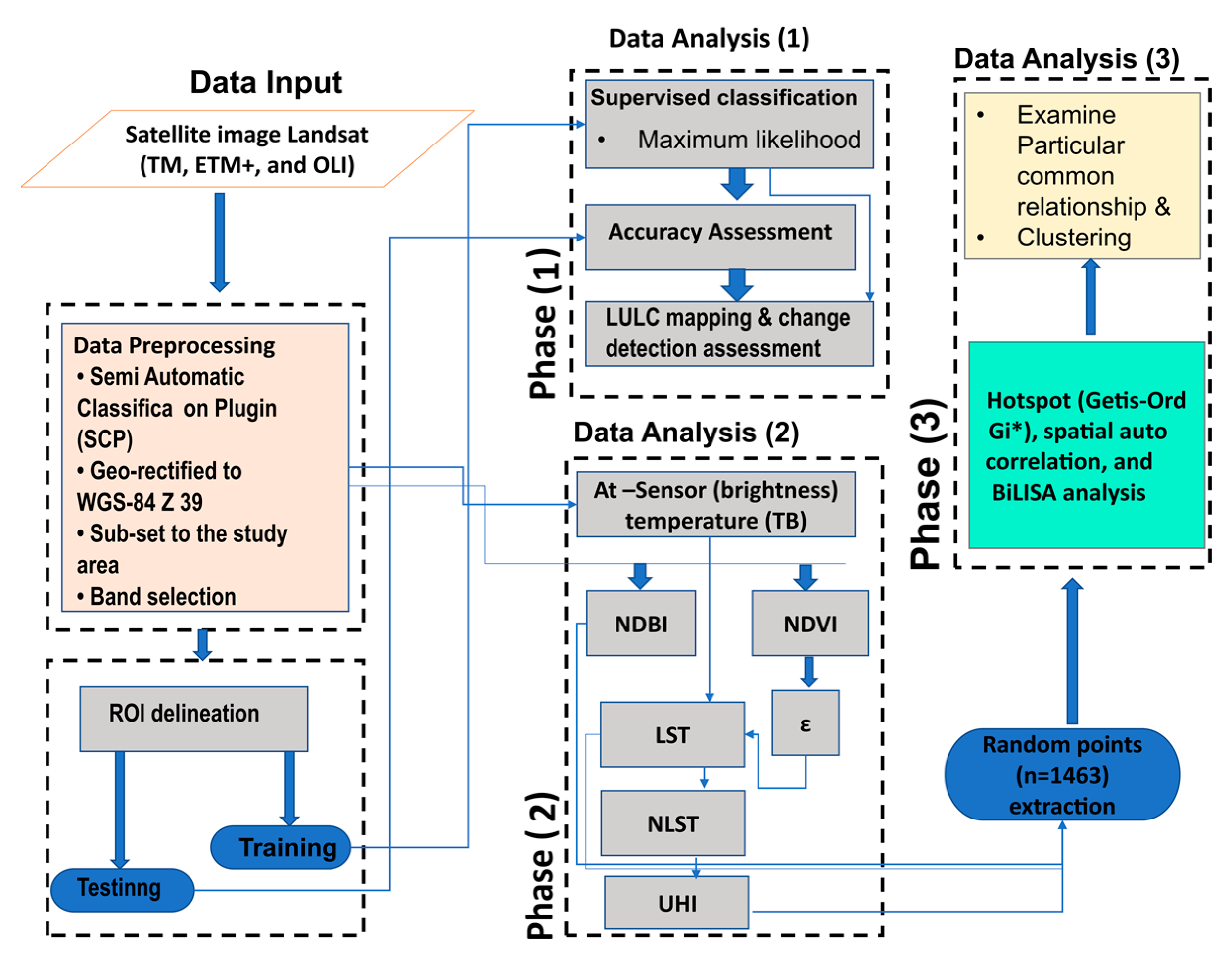
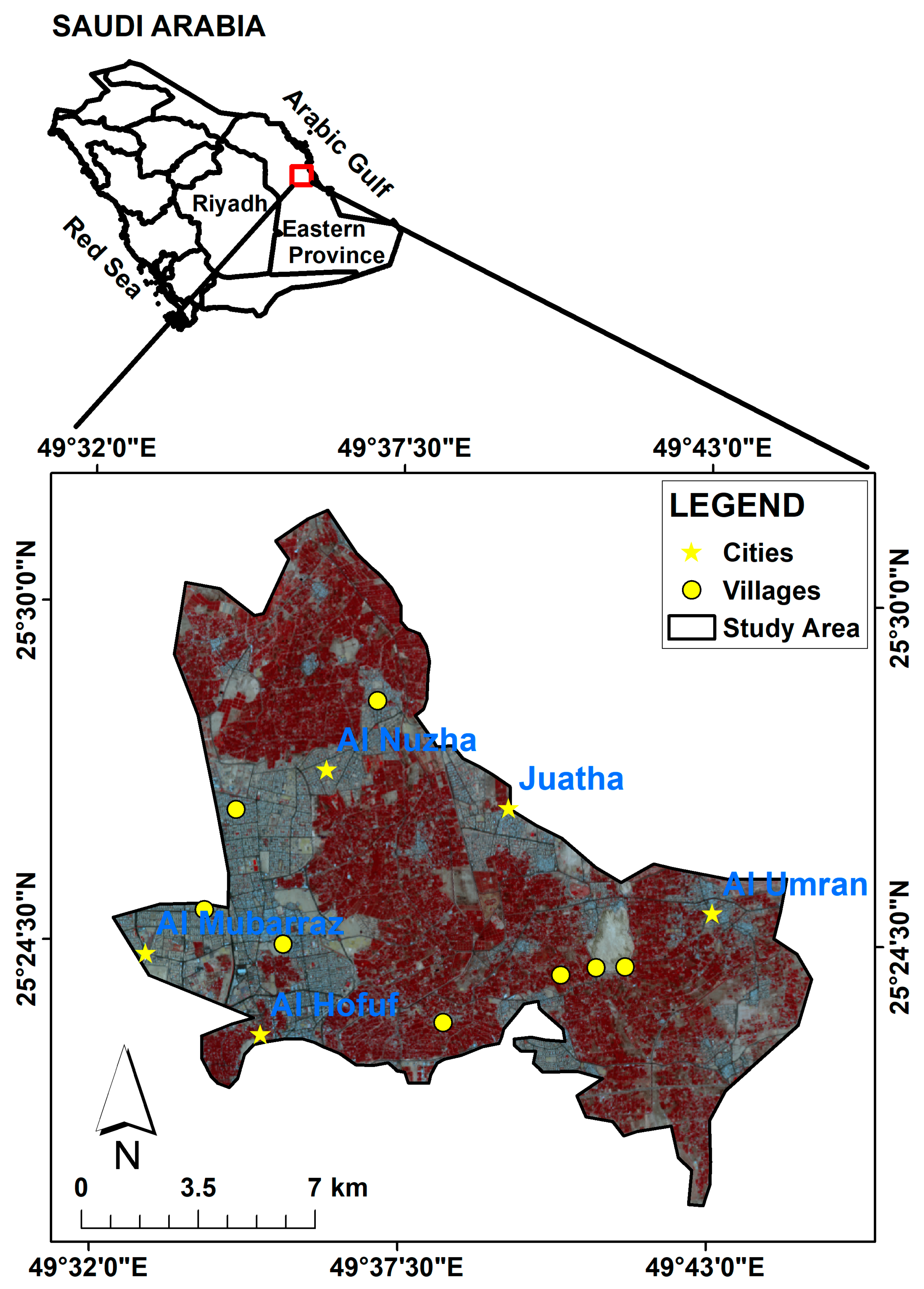

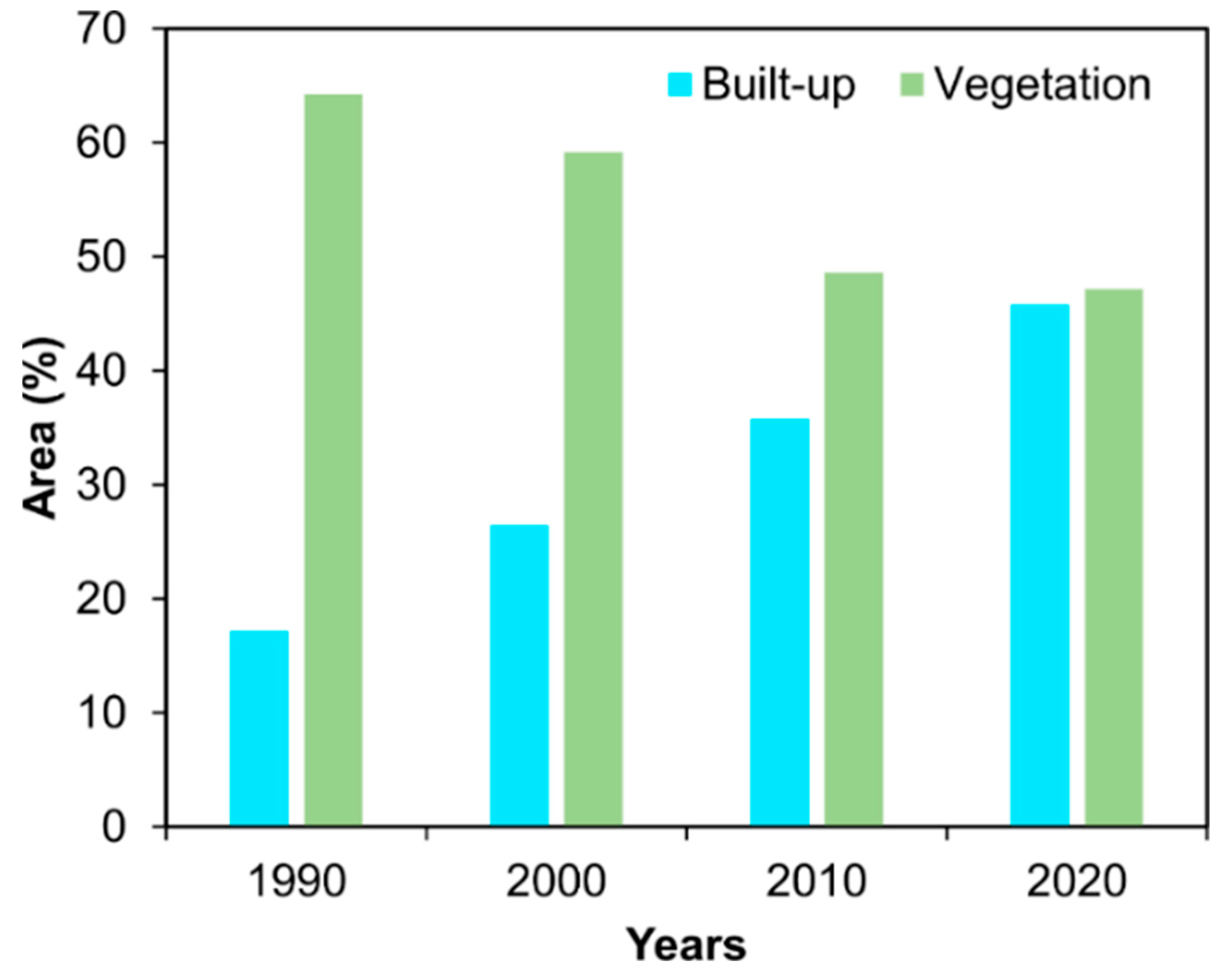
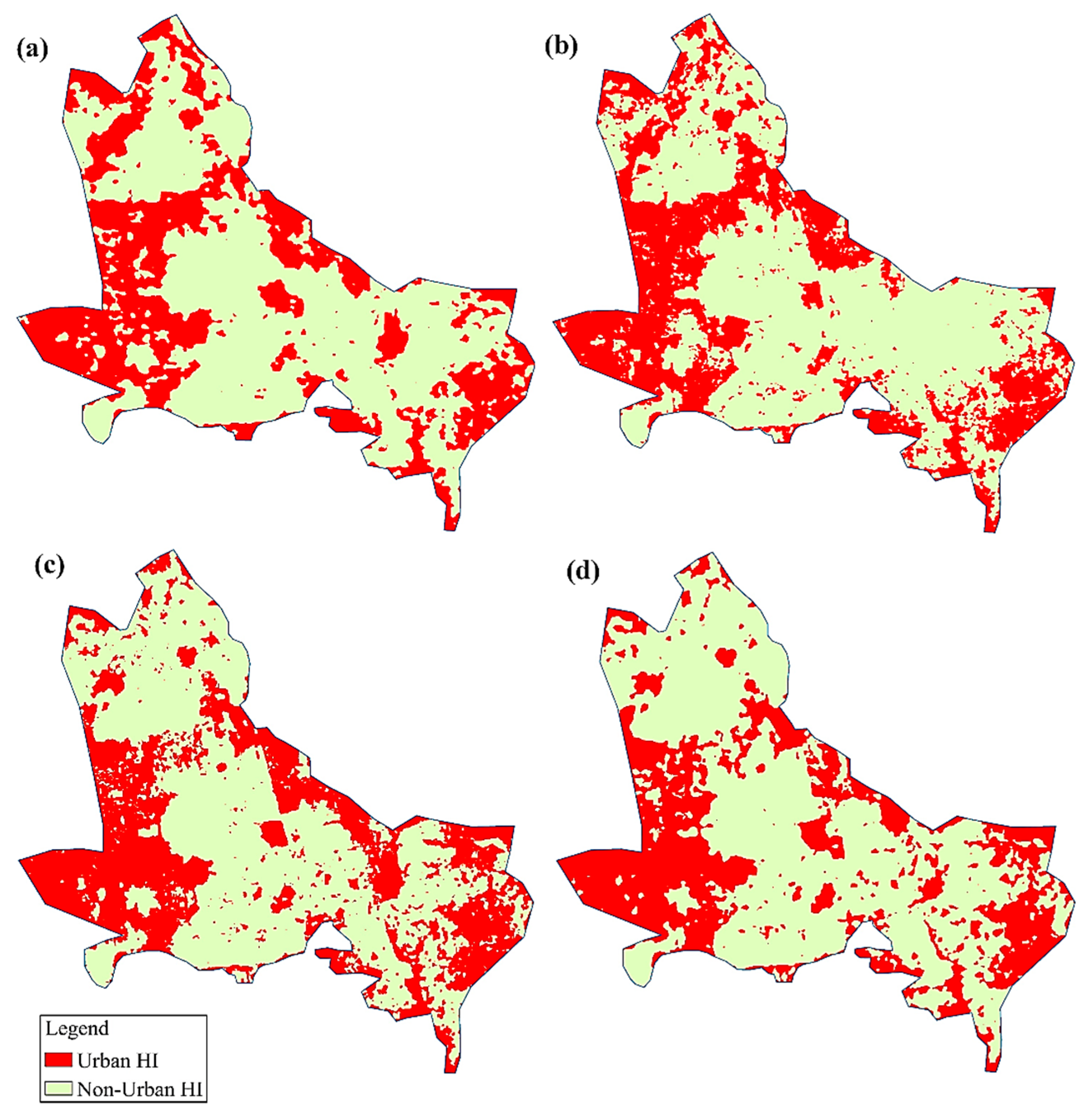
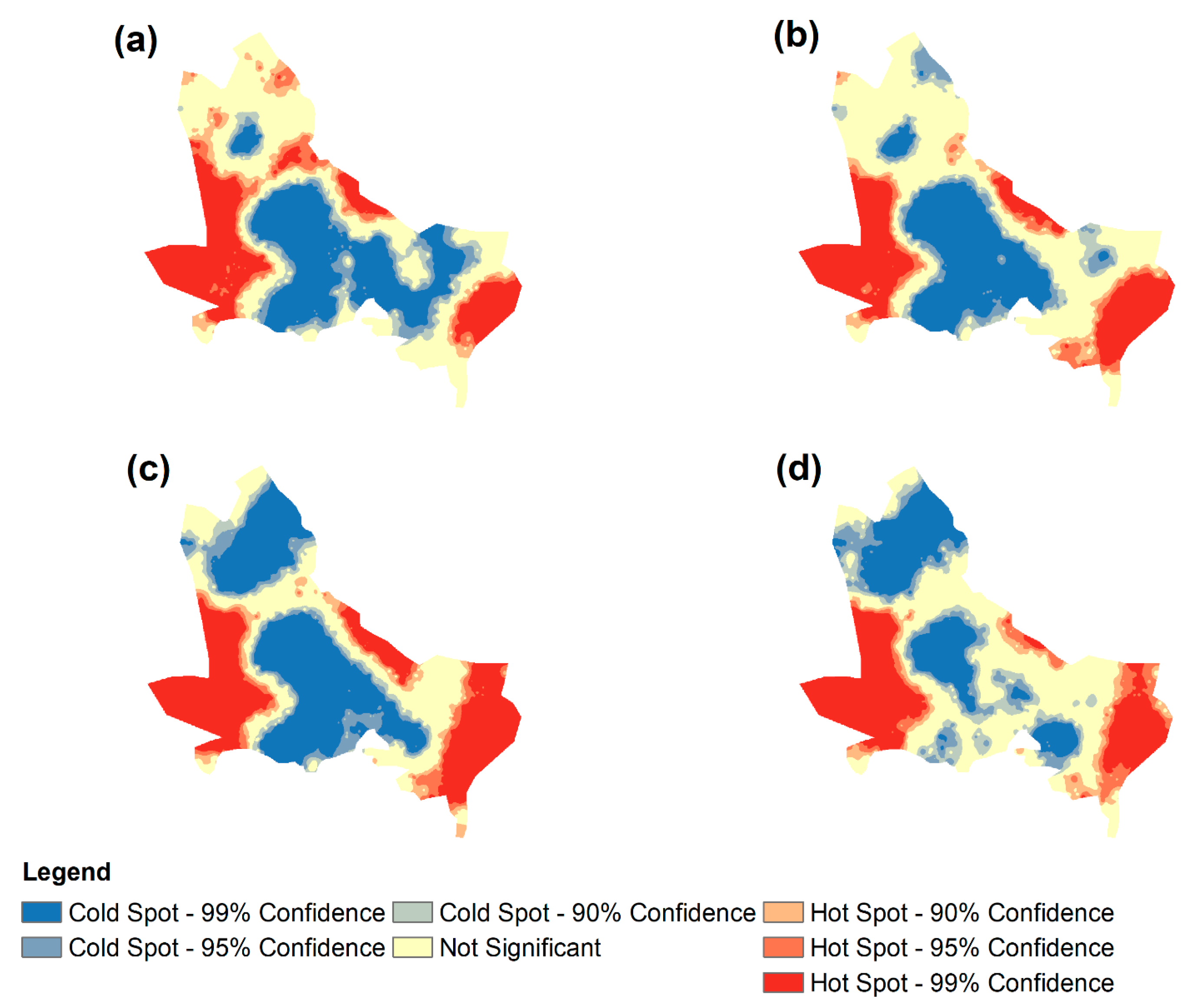
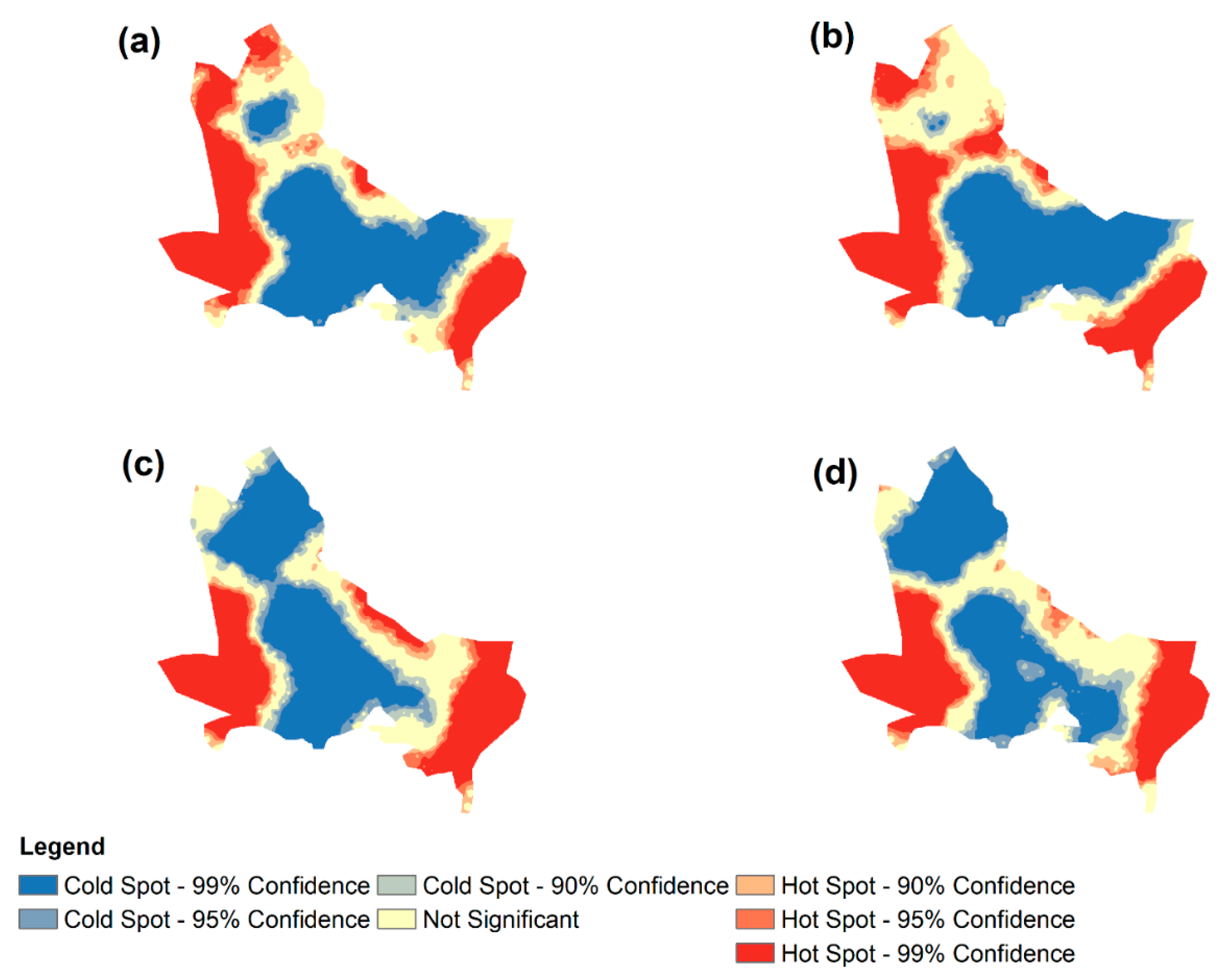
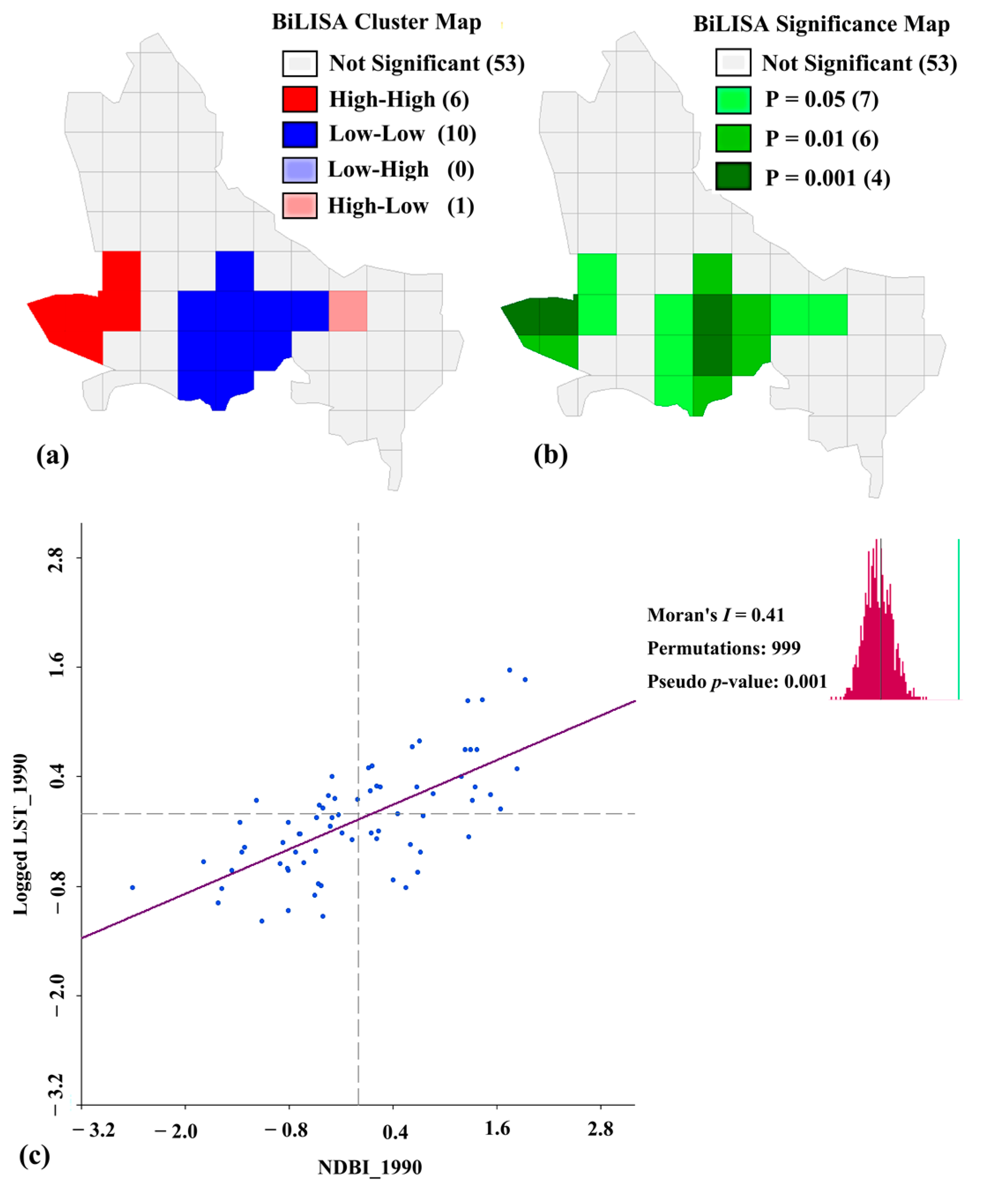

| Sensor-ID | Spacecraft-ID | Acquired Date | No. of Bands | Spatial Resolution |
|---|---|---|---|---|
| TM | Landsat-5 | 15 July 1990 | 6(reflective), 1(thermal) | 30 m (reflective), 120 m (thermal) |
| ETM+ | Landsat-7 | 2 July 2000 14 July 2010 | 6 (reflective), 2 (thermal) | 30 m (reflective), 120 m (thermal) |
| OLI and TIRS | Landsat-8 | 17 July 2020 | 8 (reflective), 2 (thermal) | 30 m (reflective), 100 m (thermal) |
| LULC Class | 1990 | 2000 | 2010 | 2020 | ||||||||||||
|---|---|---|---|---|---|---|---|---|---|---|---|---|---|---|---|---|
| UA (%) | PA (%) | OE | CE | UA (%) | PA (%) | OE | CE | UA (%) | PA (%) | OE | CE | UA (%) | PA (%) | OE | CE | |
| Vegetation | 100 | 100 | 0 | 0 | 100 | 100 | 0 | 0 | 95.12 | 100 | 0 | 4.9 | 100 | 100 | 0 | 0 |
| Built-up | 84.09 | 100 | 0 | 15.9 | 93.18 | 100 | 0 | 6.8 | 95.45 | 95.45 | 4.5 | 4.5 | 93.18 | 100 | 0 | 6.8 |
| Bare land | 88.24 | 68.18 | 31.8 | 11.8 | 94.12 | 88.89 | 11.1 | 5.9 | 94.12 | 88.89 | 0.1 | 5.9 | 88.24 | 93.75 | 6.3 | 11.8 |
| Sand dunes | 85 | 77.27 | 22.7 | 15 | 95 | 86.36 | 13.6 | 5 | 95 | 90.48 | 9.5 | 5 | 100 | 83.33 | 16.7 | 0 |
| Overall accuracy | 90.2% | 95.9% | 95.1% | 95.9% | ||||||||||||
| LU/LC Types | 1990 | 2000 | 2010 | 2020 | ||||
|---|---|---|---|---|---|---|---|---|
| Area (sq.km) | % | Area (sq.km) | % | Area (sq.km) | % | Area (sq.km) | % | |
| Vegetation | 117.08 | 64.24 | 107.76 | 59.13 | 88.52 | 48.57 | 85.91 | 47.14 |
| Built-up | 31.25 | 17.15 | 48.23 | 26.46 | 65.13 | 35.74 | 83.48 | 45.81 |
| Bare land | 10.44 | 5.73 | 15.98 | 8.77 | 14.88 | 8.17 | 4.88 | 2.68 |
| Sand dunes | 23.47 | 12.88 | 10.27 | 5.64 | 13.70 | 7.52 | 7.97 | 4.37 |
| Year | Total LST Pixels | Urban LST | Rural LST | |||||||||
|---|---|---|---|---|---|---|---|---|---|---|---|---|
| min | max | µ | δ | min | max | µ | min | max | µ | UHI-Intensity (°C) | ||
| 1990 | 31.6 | 52.4 | 40.8 | 4.1 | 42.8 | 42.8 | 52.4 | 47.6 | 31.6 | 42.8 | 37.2 | 10.4 |
| 2000 | 26.4 | 48.3 | 38.2 | 3.6 | 39.9 | 39.9 | 48.3 | 44.1 | 26.4 | 39.9 | 33.2 | 10.9 |
| 2010 | 31.7 | 47.8 | 39.4 | 3.5 | 41.2 | 41.2 | 47.8 | 44.5 | 31.7 | 41.2 | 36.4 | 8.1 |
| 2020 | 36.3 | 53.7 | 45.6 | 3.1 | 47.1 | 47.1 | 53.7 | 50.4 | 36.3 | 47.1 | 41.7 | 8.7 |
| Years | NDBI | LST | ||||||
|---|---|---|---|---|---|---|---|---|
| Min. | Max. | Mean | SD | Min. | Max. | Mean | SD | |
| 1990 | −0.39 | 0.21 | −0.06 | 0.12 | 31.6 | 52.4 | 40.8 | 4.1 |
| 2000 | −0.33 | 0.23 | −0.03 | 0.11 | 26.4 | 48.3 | 38.2 | 3.6 |
| 2010 | −0.22 | 0.17 | −0.03 | 0.10 | 31.7 | 47.9 | 39.4 | 3.5 |
| 2020 | −0.39 | 0.35 | −0.05 | 0.11 | 36.3 | 53.7 | 45.6 | 3.1 |
| Spot Type | NDBI | LST | ||||||
|---|---|---|---|---|---|---|---|---|
| 1990 | 2000 | 2010 | 2020 | 1990 | 2000 | 2010 | 2020 | |
| Cold Spot—99% Confidence | 24.3 | 22.3 | 30.7 | 19 | 34.0 | 33.9 | 35.3 | 35.1 |
| Cold Spot—95% Confidence | 6.9 | 5.7 | 6.9 | 8.2 | 4.9 | 3.7 | 5.6 | 7.1 |
| Cold Spot—90% Confidence | 6.6 | 6.3 | 5.4 | 9.3 | 4.7 | 3.6 | 5.6 | 5.7 |
| Not Significant | 30.6 | 35.2 | 21.4 | 31.9 | 19.2 | 19.7 | 18.3 | 19.7 |
| Hot Spot—90% Confidence | 6.6 | 5.0 | 4.8 | 5.2 | 5.7 | 6.0 | 3.9 | 4.2 |
| Hot Spot—95% Confidence | 5.4 | 4.7 | 4.2 | 5.7 | 5.1 | 5.5 | 3.5 | 3.2 |
| Hot Spot—99% Confidence | 19.5 | 20.8 | 26.5 | 20.7 | 26.4 | 27.7 | 27.8 | 25.0 |
| Moran’s I | 0.409 | 0.385 | 0.486 | 0.322 | 0.639 | 0.605 | 0.604 | 0.615 |
Disclaimer/Publisher’s Note: The statements, opinions and data contained in all publications are solely those of the individual author(s) and contributor(s) and not of MDPI and/or the editor(s). MDPI and/or the editor(s) disclaim responsibility for any injury to people or property resulting from any ideas, methods, instructions or products referred to in the content. |
© 2023 by the authors. Licensee MDPI, Basel, Switzerland. This article is an open access article distributed under the terms and conditions of the Creative Commons Attribution (CC BY) license (https://creativecommons.org/licenses/by/4.0/).
Share and Cite
Hassaballa, A.; Salih, A. A Spatio-Temporal Analysis of Heat Island Intensity Influenced by the Substantial Urban Growth between 1990 and 2020: A Case Study of Al-Ahsa Oasis, Eastern Saudi Arabia. Appl. Sci. 2023, 13, 2755. https://doi.org/10.3390/app13052755
Hassaballa A, Salih A. A Spatio-Temporal Analysis of Heat Island Intensity Influenced by the Substantial Urban Growth between 1990 and 2020: A Case Study of Al-Ahsa Oasis, Eastern Saudi Arabia. Applied Sciences. 2023; 13(5):2755. https://doi.org/10.3390/app13052755
Chicago/Turabian StyleHassaballa, Abdalhaleem, and Abdelrahim Salih. 2023. "A Spatio-Temporal Analysis of Heat Island Intensity Influenced by the Substantial Urban Growth between 1990 and 2020: A Case Study of Al-Ahsa Oasis, Eastern Saudi Arabia" Applied Sciences 13, no. 5: 2755. https://doi.org/10.3390/app13052755







